- Joined
- Jul 1, 2014
- Messages
- 3,723 (0.95/day)
Creative had a positive impact on us at TechPowerUp who attended CES last year, with their retail demonstration of Super X-Fi headphone holography arguably being the most impressive product announcement at the trade show. Yours truly was especially taken aback with the hardware implementation of Super X-Fi, with the first product implementing it, the SXFI Amp, earning a well-deserved recommendation too. Naturally, we were eager to see what the company was up to next, and met them at CES this year too where it was evident they were going all aboard the Super X-Fi train, and inviting everyone along for the ride.
There were definitely a lot of hardware products with the SXFI DSP built in, but the main announcement was in the form of the new Super X-Fi Gen 2 audio profile. Gen 1, from last year, garnered a lot of positive reviews, but also had mixed reception from the general populace who had to rely on head mapping and not also the microphone-based measurements the press got in person. Indeed, my own experience with higher end headphones was not as positive, with music losing detail in favor of a surround sound speaker setup experience that perhaps was not necessary. The worse the audio source was, the worse this discrepancy was as well. Creative had gathered tens of thousands of ear profiles and feedback this past year, and used it to train their Super X-Fi AI engine to develop a more accurate, personalized audio profile as part of Super X-Fi Gen 2. The company claims this free update to all existing Gen 1 profiles will improve also the preservation of audio detail, as well as better positional accuracy as well. We will put this to the test soon enough, but read past the break on more new announcements from Creative, including all the new hardware with this technology built in.


Our tour began with a live demo of Super X-Fi Gen 2 which was, as with Gen 1, extremely impressive. Indeed, there are now two more audio channels supported aside from the 7.1 before, in the form of a wide left and wide right. There is also more personalization allowed for dedicated profiles, be it for gaming or movies, which in turn have resulted in some tuned hardware shown off as well which we will see below. Lastly, Creative claims Gen 2 is more efficient in power consumption as well, with an example given of their SXFI AIR wireless headphones now gaining over 10% higher battery life than before. These are bold claims no doubt, but then they teased us with a mention of Super X-Fi Gen 3 already in the works for even more improvements, and one that we will likely see at CES 20201.
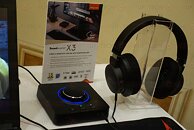


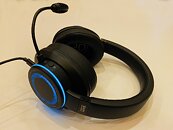

Our hardware tour began with a look at the recently launched Sound Blaster X3 sound card with hardware Super X-Fi. This came out in Q4 last year, and allowed the hardware-based SXFI DSP to work with all supported headphones, along with the better Amp/DAC here compared to the SXFI Amp, as covered before. The first new-to-CES 2020 product came in the form of the Creative SXFI GAMER headset, which has a custom gaming Gen 2 profile pre-configured in the integrated SXFI DSP. This is an analogous product to their SXFI Theater wireless headphones, which is meant to target movies and the living room experience, but uses USB connectivity to power and drive the headphones, as well as the RGB LEDs surrounding the earcups. The microphone has a pop filter for noise isolation, and Creative aims to launch the SXFI GAMER in Q2 2020 for a price point under $150 (not finalized yet, but they said they were looking at a number closer to $125 at the moment).


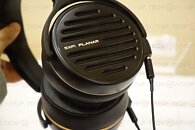

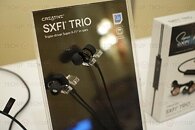
Targeting the audiophiles was a concept over-the-ears headphones using large planar magnetic drivers. Aptly called SXFI PLANAR, this was definitely the best sounding new product they had, but is also too early to really discuss more than what you see in the images above. There is an in-line smaller and lighter version of the SXFI AMP in the cable called SXFI WIRE, and Creative is seeking input from our readers on what the output connection should be, as well as the type of sound signature they should aim for. This was next to a more ready audio solution, also targeting the higher-end relative to the others, the all-new SXFI TRIO in-ear headphones with a hybrid triple driver system. These also have an in-line SXFI WIRE, and terminate in a USB Type-C connector to use with mobile devices for people on the go.

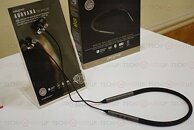



Continuing their support of in-ear headphones was the new Aurvana Trio Wireless, which is a wireless neckband-style headphones with software-based Super X-Fi only. This means that the Aurava Trio Wireless will be on the compatible list in the SXFI app, but will need the SXFI Amp to make the most of it, including the DSP and playback of all audio and not just those on your device via the app. Rounding off the demo, in a whole separate room again, was the other end of the SXFI ecosystem with the SXFI CARRIER sound bar. This is not meant to replace Creative's flagship sound bar, the X-Fi SONIC CARRIER, but targets a sub-$1000 price point and offers, as you guessed by now, hardware Super X-Fi support. The SXFI CARRIER was developed in collaboration with Dolby, and has Atmos 7.1 surround sound technology combined with Super X-Fi for headphones. The soundbar itself is impressive sounding and powerful for its 34.6" length, and is paired with a 10" subwoofer that completes the 7.1 experience with 7 speakers in the soundbar and a total of 450 W output. I/O comes in the form of an HDMI eARC port, two HDMI 2.1 ports, a 3.5 mm analog jack for headphones to use Super X-Fi for when the soundbar is too loud, Bluetooth 5.0 connectivity to use with wireless headphones in general, and USB Type-C connectivity to use with some of the SXFI headphones that terminate in a Type-C connector.

Creative also showed off the more budget-oriented OUTLIER ONE V2 wireless in-ear headphones for active users on the go, a prototype CLEVO laptop that integrates and SFXI DSP, a face-lifted SXFI AIR wireless headphones, as well as the recently released OUTLIER AIR and OUTLIER GOLD true wireless earbuds that boast best-in-class rated battery life on a single use cycle. We have some of these in hand for more testing, especially as a demonstration of Super X-Fi Gen 2, so look out for more on this subject coming your way.
View at TechPowerUp Main Site
There were definitely a lot of hardware products with the SXFI DSP built in, but the main announcement was in the form of the new Super X-Fi Gen 2 audio profile. Gen 1, from last year, garnered a lot of positive reviews, but also had mixed reception from the general populace who had to rely on head mapping and not also the microphone-based measurements the press got in person. Indeed, my own experience with higher end headphones was not as positive, with music losing detail in favor of a surround sound speaker setup experience that perhaps was not necessary. The worse the audio source was, the worse this discrepancy was as well. Creative had gathered tens of thousands of ear profiles and feedback this past year, and used it to train their Super X-Fi AI engine to develop a more accurate, personalized audio profile as part of Super X-Fi Gen 2. The company claims this free update to all existing Gen 1 profiles will improve also the preservation of audio detail, as well as better positional accuracy as well. We will put this to the test soon enough, but read past the break on more new announcements from Creative, including all the new hardware with this technology built in.


Our tour began with a live demo of Super X-Fi Gen 2 which was, as with Gen 1, extremely impressive. Indeed, there are now two more audio channels supported aside from the 7.1 before, in the form of a wide left and wide right. There is also more personalization allowed for dedicated profiles, be it for gaming or movies, which in turn have resulted in some tuned hardware shown off as well which we will see below. Lastly, Creative claims Gen 2 is more efficient in power consumption as well, with an example given of their SXFI AIR wireless headphones now gaining over 10% higher battery life than before. These are bold claims no doubt, but then they teased us with a mention of Super X-Fi Gen 3 already in the works for even more improvements, and one that we will likely see at CES 20201.





Our hardware tour began with a look at the recently launched Sound Blaster X3 sound card with hardware Super X-Fi. This came out in Q4 last year, and allowed the hardware-based SXFI DSP to work with all supported headphones, along with the better Amp/DAC here compared to the SXFI Amp, as covered before. The first new-to-CES 2020 product came in the form of the Creative SXFI GAMER headset, which has a custom gaming Gen 2 profile pre-configured in the integrated SXFI DSP. This is an analogous product to their SXFI Theater wireless headphones, which is meant to target movies and the living room experience, but uses USB connectivity to power and drive the headphones, as well as the RGB LEDs surrounding the earcups. The microphone has a pop filter for noise isolation, and Creative aims to launch the SXFI GAMER in Q2 2020 for a price point under $150 (not finalized yet, but they said they were looking at a number closer to $125 at the moment).





Targeting the audiophiles was a concept over-the-ears headphones using large planar magnetic drivers. Aptly called SXFI PLANAR, this was definitely the best sounding new product they had, but is also too early to really discuss more than what you see in the images above. There is an in-line smaller and lighter version of the SXFI AMP in the cable called SXFI WIRE, and Creative is seeking input from our readers on what the output connection should be, as well as the type of sound signature they should aim for. This was next to a more ready audio solution, also targeting the higher-end relative to the others, the all-new SXFI TRIO in-ear headphones with a hybrid triple driver system. These also have an in-line SXFI WIRE, and terminate in a USB Type-C connector to use with mobile devices for people on the go.





Continuing their support of in-ear headphones was the new Aurvana Trio Wireless, which is a wireless neckband-style headphones with software-based Super X-Fi only. This means that the Aurava Trio Wireless will be on the compatible list in the SXFI app, but will need the SXFI Amp to make the most of it, including the DSP and playback of all audio and not just those on your device via the app. Rounding off the demo, in a whole separate room again, was the other end of the SXFI ecosystem with the SXFI CARRIER sound bar. This is not meant to replace Creative's flagship sound bar, the X-Fi SONIC CARRIER, but targets a sub-$1000 price point and offers, as you guessed by now, hardware Super X-Fi support. The SXFI CARRIER was developed in collaboration with Dolby, and has Atmos 7.1 surround sound technology combined with Super X-Fi for headphones. The soundbar itself is impressive sounding and powerful for its 34.6" length, and is paired with a 10" subwoofer that completes the 7.1 experience with 7 speakers in the soundbar and a total of 450 W output. I/O comes in the form of an HDMI eARC port, two HDMI 2.1 ports, a 3.5 mm analog jack for headphones to use Super X-Fi for when the soundbar is too loud, Bluetooth 5.0 connectivity to use with wireless headphones in general, and USB Type-C connectivity to use with some of the SXFI headphones that terminate in a Type-C connector.

Creative also showed off the more budget-oriented OUTLIER ONE V2 wireless in-ear headphones for active users on the go, a prototype CLEVO laptop that integrates and SFXI DSP, a face-lifted SXFI AIR wireless headphones, as well as the recently released OUTLIER AIR and OUTLIER GOLD true wireless earbuds that boast best-in-class rated battery life on a single use cycle. We have some of these in hand for more testing, especially as a demonstration of Super X-Fi Gen 2, so look out for more on this subject coming your way.
View at TechPowerUp Main Site






